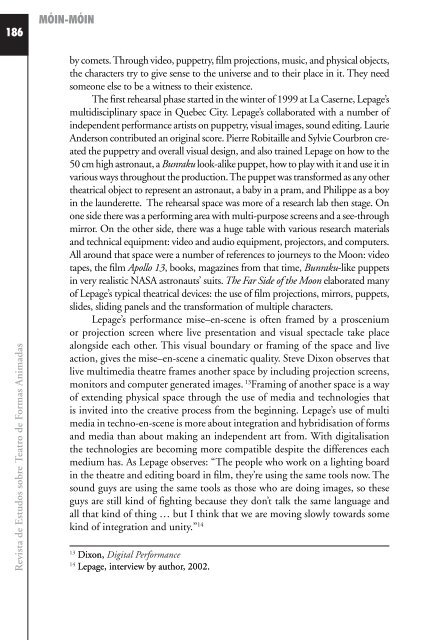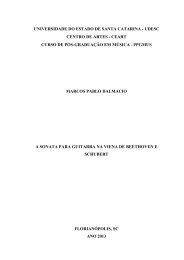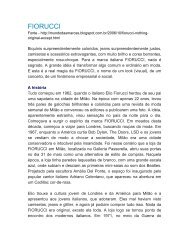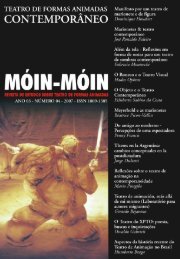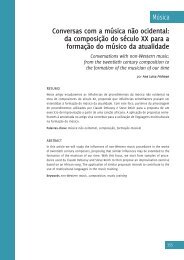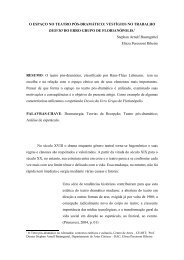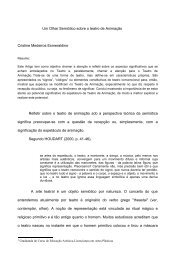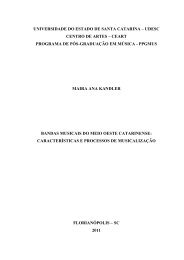Edição e distribuição www.designeditora.com.br Tipologia Adobe ...
Edição e distribuição www.designeditora.com.br Tipologia Adobe ...
Edição e distribuição www.designeditora.com.br Tipologia Adobe ...
You also want an ePaper? Increase the reach of your titles
YUMPU automatically turns print PDFs into web optimized ePapers that Google loves.
186<<strong>br</strong> />
Revista de Estudos so<strong>br</strong>e Teatro de Formas Animadas<<strong>br</strong> />
MÓIN-MÓIN<<strong>br</strong> />
by <strong>com</strong>ets. Through video, puppetry, film projections, music, and physical objects,<<strong>br</strong> />
the characters try to give sense to the universe and to their place in it. They need<<strong>br</strong> />
someone else to be a witness to their existence.<<strong>br</strong> />
The first rehearsal phase started in the winter of 1999 at La Caserne, Lepage’s<<strong>br</strong> />
multidisciplinary space in Quebec City. Lepage’s collaborated with a number of<<strong>br</strong> />
independent performance artists on puppetry, visual images, sound editing. Laurie<<strong>br</strong> />
Anderson contributed an original score. Pierre Robitaille and Sylvie Cour<strong>br</strong>on created<<strong>br</strong> />
the puppetry and overall visual design, and also trained Lepage on how to the<<strong>br</strong> />
50 cm high astronaut, a Bunraku look-alike puppet, how to play with it and use it in<<strong>br</strong> />
various ways throughout the production. The puppet was transformed as any other<<strong>br</strong> />
theatrical object to represent an astronaut, a baby in a pram, and Philippe as a boy<<strong>br</strong> />
in the launderette. The rehearsal space was more of a research lab then stage. On<<strong>br</strong> />
one side there was a performing area with multi-purpose screens and a see-through<<strong>br</strong> />
mirror. On the other side, there was a huge table with various research materials<<strong>br</strong> />
and technical equipment: video and audio equipment, projectors, and <strong>com</strong>puters.<<strong>br</strong> />
All around that space were a number of references to journeys to the Moon: video<<strong>br</strong> />
tapes, the film Apollo 13, books, magazines from that time, Bunraku-like puppets<<strong>br</strong> />
in very realistic NASA astronauts’ suits. The Far Side of the Moon elaborated many<<strong>br</strong> />
of Lepage’s typical theatrical devices: the use of film projections, mirrors, puppets,<<strong>br</strong> />
slides, sliding panels and the transformation of multiple characters.<<strong>br</strong> />
Lepage’s performance mise–en-scene is often framed by a proscenium<<strong>br</strong> />
or projection screen where live presentation and visual spectacle take place<<strong>br</strong> />
alongside each other. This visual boundary or framing of the space and live<<strong>br</strong> />
action, gives the mise–en-scene a cinematic quality. Steve Dixon observes that<<strong>br</strong> />
live multimedia theatre frames another space by including projection screens,<<strong>br</strong> />
monitors and <strong>com</strong>puter generated images. 13 Framing of another space is a way<<strong>br</strong> />
of extending physical space through the use of media and technologies that<<strong>br</strong> />
is invited into the creative process from the beginning. Lepage’s use of multi<<strong>br</strong> />
media in techno-en-scene is more about integration and hy<strong>br</strong>idisation of forms<<strong>br</strong> />
and media than about making an independent art from. With digitalisation<<strong>br</strong> />
the technologies are be<strong>com</strong>ing more <strong>com</strong>patible despite the differences each<<strong>br</strong> />
medium has. As Lepage observes: “The people who work on a lighting board<<strong>br</strong> />
in the theatre and editing board in film, they’re using the same tools now. The<<strong>br</strong> />
sound guys are using the same tools as those who are doing images, so these<<strong>br</strong> />
guys are still kind of fighting because they don’t talk the same language and<<strong>br</strong> />
all that kind of thing … but I think that we are moving slowly towards some<<strong>br</strong> />
kind of integration and unity.” 14<<strong>br</strong> />
13 Dixon, Digital Performance<<strong>br</strong> />
14 Lepage, interview by author, 2002.


